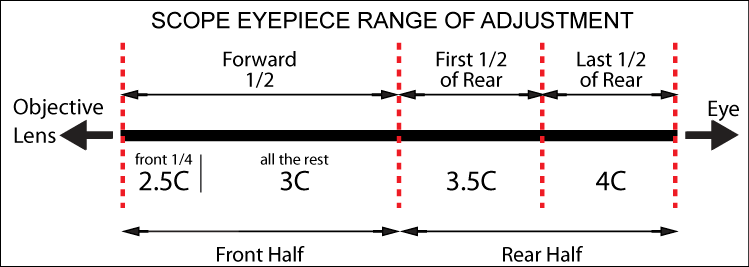
Use the method below to discover which number booster is correct for you.
(If you wear glasses, perform this test with and without your glasses.)
Determining total travel of eyepiece
Tools needed: Calipers (using millimeters) and a calculator.
If your scope has a lock ring: Make sure the threads are clean. Screw the lock ring all the way forward (clockwise).
If your scope does not have a lock ring: Screw the eyepiece all the way forward and put a small piece of masking tape on your scope at the very end of the eyepiece to mark where “all the way forward” is. Now screw the eyepiece counterclockwise all the way out.
Measure the distance between the eyepiece and the lock ring or masking tape. Divide that number by four and write it down.
Point your scope at the sky and slowly screw the eyepiece in (clockwise) until you have clear, crisp crosshairs. Back off the eyepiece until just before the crosshairs begin to fade. Measure the distance that is left over.
If the distance left over is:
- Less than the number you wrote down - you need a 2.5 booster.
- More than the number you wrote down, but less than twice the number you wrote down - you need a 3.0 booster.
- More than twice the number you wrote down, but less than 3 times the number you wrote down - you need a 3.5 booster.
- More than 3 times the number you wrote down - you need a 4.0 booster.
- When your calculation falls on the cusp of the change of one number to the next ALWAYS go with the next number up, but don't exaggerate.
What is parallax and what causes it?
Parallax is created when the distance through a lens changes. A glass pane is flat. A glass lens is curved. The thickest part of a lens is the center. As you move outside of center, the glass becomes thinner. This change in distance through the lens is what creates parallax. Parallax is a minute of angle (moa) issue.
To experience parallax, sight a target some distance away and put that target out of focus. Physically move your eye up and down in the eyepiece and notice that the crosshairs move up/down as well. Grasp your parallax focus adjuster while physically moving your eye up/down in the eyepiece and turn the adjuster until the crosshairs have stopped moving. Take note of your grasp on the parallax focus adjuster and continue turning in the same direction until it appears that the crosshairs have started moving again. Set your parallax adjuster knob in the center of where the crosshairs stopped moving and started moving.
We want you to be happy with your BulzEyePro® Optical Booster purchase. Please read the information below and contact us using the form below if you have any questions.
For handgun scopes: (Handgun scope boosters will decrease eye relief and increase the size of your target. The higher the number, the more the decrease in your eye relief.) Anyone interested in handgun scopes should use the booster recommendation inquiry form below before ordering.

About the above graphic: You can see that the 2.5 lens is less than 1/4 of the way. For example, if your number divided by 4 equals 25 and you screw your eyepiece forward and it comes out to 23 or 24 go with the 3.
Still Not Sure Which Optical Booster is Right for Your Eyes?
Please contact us and someone will assist you to determine which booster is right for you.
Call us at 207-626-0000 and leave a message with your name, your phone number, where you live in the world (time zone), and a good time to call. Someone will return your call. You may also use the email contact form below.
Considering a Gift Purchase?
If this is a gift, please contact us for a recommendation.
We Now Have Boosters for Everyone!
Our boosters were initially designed for people over the age of 50 and for younger people with imperfect near-vision (4-18” sight range). Using our latest technology (5th generation), we now have designed boosters that will work for everyone! For the correct booster for you, be sure to take the test above.
Contact BulzEyePro® for an Optical Booster Recommendation
If you have general questions and don't need a booster recommendation,
please use our shorter contact page form.


